DSC-L1: Sony's Latest Ultra-Compact Digicam
by Stephen Caston on January 27, 2005 12:05 AM EST- Posted in
- Digital Camera
General Image Quality
For these pictures, the camera was reset to its factory default setting. Then, it was set to its highest quality recording setting. The pictures were then taken in Auto mode unless otherwise stated. Portrait-style images have been rotated using Irfanview's "lossless operations". Click on a thumbnail to view the full-size image. The crops below the thumbnails are 100%. All images are sRGB.  Click to enlarge. |
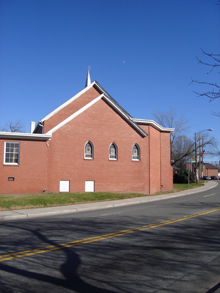 Click to enlarge. |
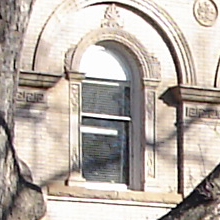 |
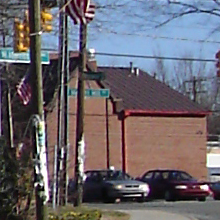 |
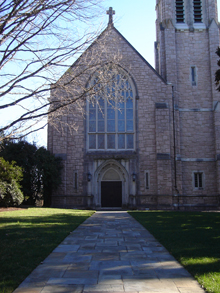 Click to enlarge. |
 Click to enlarge. |
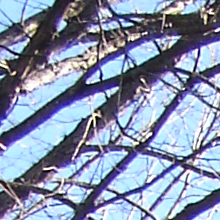 |
 |
In the first image above, the L1 proves capable of capturing a good amount of detail. However, the camera has slightly overexposed this image and we noticed some blurring near the corners. In the second image, we have cropped out a portion of the image that exemplifies a common image quality point. Although the camera captures a fair amount of detail, the details are quite soft in appearance. In the third sample, we have cropped out a portion of the image that shows fairly strong purple fringing. We did not find purple fringing to be a very common problem except in extreme circumstances like this. In the third image, we also want to point out that the L1's slight cool Auto WB in combination with the shade gives this image a bluish color cast. In the final sample, we have highlighted a common problem with this camera. In shots like this where we extended the lens to its telephoto position, we noticed more significant blurring at the edges in shots taken at wide angle. In addition, the blurring appears to begin closer to the center of the image and worsens near the edges. Overall, the image quality is unimpressive because of the soft/muddy quality and the blurring near the edges of many of our pictures. When we set the camera to "+" sharpening, we were not able to gain any more detail. When sharpness was boosted, we began to notice JPEG artifacts and the same soft look in the details.
| Twilight Mode |
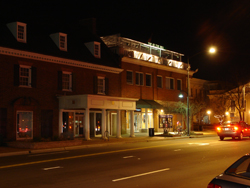 (f/3.5, 1.6 sec., ISO 100) Click to enlarge. |
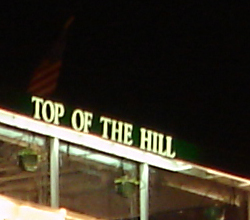 |
With a maximum shutter speed of 2 seconds in Twilight mode, the L1 is able to capture some impressive night shots with relatively low noise levels. When the shutter speed is slower than 1/6th sec., the camera utilizes noise reduction automatically to help produce images with less noise.
| Movie Mode | |
 (640x480, 30 fps) Click to view. |
 (640x480, 16 fps) Click to view. |
We are fairly impressed with the movie mode of the L1. At the highest quality, the clips are very smooth at 30 fps and the image quality is outstanding. When compared to the clip at 16 fps, you can see the benefit of shooting with Fine quality. We should point out that you will need a Memory Stick Pro Duo in order to utilize Fine mode. Otherwise, the flash card will not be able to keep up with the data stream.










7 Comments
View All Comments
ksherman - Sunday, January 30, 2005 - link
BTW #6-- to get to contact information, click on 'about' on the left hadn menu (second down) and then click on 'contactAnandtech'Xmate - Saturday, January 29, 2005 - link
Good review, camera seems weak to me (being a photographer) but for a digicam its good, and a good review of it.I notice that Anandtech has taken a liking to digital photography, having several reviews and essays on how to take better photographs and what to take them with. This is all very good. I am really happy that more people are getting involved into the world of photography.
What I ask of Anandtech now, is to continue on their photography reviews, but to add some computer software preformance reviews. I am in the market for a new computer, and i am completely torn as to what CPU, motherboard, ram, graphics card HD to get. I will be using almost exclusively Adobe products on the computer (photoshop, illustrator, Golive Indesign, The whole Creative suite). I'd GREATLY aoreicate if Anandtech could have some benchmarkings of how different Hardware preforms in photoshop and more importantly their ram converter.
Also, I ask that you could perhaps have some reviews of colour calibration devices, such as the Gretagmacbeth ones (www.gretagmacbeth.com) and also if you could tell us what monitors are the best to use for the most acurate colour rendition.
It's great that you have more photographers articles, but people like me (you'd be surprised how many of us visit this site) really need advice on what PC hardware to get for the best and faster results, from cpu to graphics card to monitor to printer. I hope you take this into consideration.
Stefan
PS: I was looking for the 'Contact Us' for Anandtech, but I was unable to find it. If someone could tell me how to contact them directly then I'd greatly apreciate it. Thank you once again.
melgross - Friday, January 28, 2005 - link
As far as I am concerned, all of the test pictures are unacceptable. The outdoor pics aren't bad, though there are better images from others cameras in this price range.The indoor pics are all underexposed badly, and the flash calibration esp. at close distances is very poor.
segagenesis - Thursday, January 27, 2005 - link
Better and less than half the price of my old (4 years old?) DSC-P1. Guess it shows how quickly cameras are evolving.There will always be some edge distortion in smaller cameras, so when buying one this is a given. The lens is just too damn small!
stephencaston - Thursday, January 27, 2005 - link
#1 thanks, its corrected nowarfan - Thursday, January 27, 2005 - link
Maybe it will be better if there is review for all digital camera from entry level until high-end. What about Canon A75 compare with this Sony ?cosmotic - Thursday, January 27, 2005 - link
Are you sure you meant that the release date was Feb 2004?